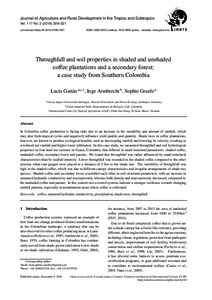| dc.date.accessioned | 2016-12-15T08:02:42Z | |
| dc.date.available | 2016-12-15T08:02:42Z | |
| dc.date.issued | 2016-12-09 | |
| dc.identifier.issn | 1612-9830 | |
| dc.identifier.issn | 2363-6033 | |
| dc.identifier.uri | urn:nbn:de:hebis:34-2016101851061 | |
| dc.identifier.uri | http://hdl.handle.net/123456789/2016101851061 | |
| dc.language.iso | eng | |
| dc.publisher | Kassel University Press | ger |
| dc.rights | Urheberrechtlich geschützt | |
| dc.rights.uri | https://rightsstatements.org/page/InC/1.0/ | |
| dc.subject | coffee | eng |
| dc.subject | saturated hydraulic conductivity | eng |
| dc.subject | precipitation | eng |
| dc.subject | shade trees | eng |
| dc.subject | throughfall | eng |
| dc.subject.ddc | 630 | |
| dc.title | Throughfall and soil properties in shaded and unshaded coffee plantations and a secondary forest: a case study from Southern Colombia | eng |
| dc.type | Aufsatz | |
| dcterms.abstract | In Colombia coffee production is facing risks due to an increase in the variability and amount of rainfall, which may alter hydrological cycles and negatively influence yield quality and quantity. Shade trees in coffee plantations, however, are known to produce ecological benefits, such as intercepting rainfall and lowering its velocity, resulting in a reduced net-rainfall and higher water infiltration. In this case study, we measured throughfall and soil hydrological properties in four land use systems in Cauca, Colombia, that differed in stand structural parameters: shaded coffee, unshaded coffee, secondary forest and pasture. We found that throughfall was rather influenced by stand structural characteristics than by rainfall intensity. Lower throughfall was recorded in the shaded coffee compared to the other systems when rain gauges were placed at a distance of 1.0 m to the shade tree. The variability of throughfall was high in the shaded coffee, which was due to different canopy characteristics and irregular arrangements of shade tree species. Shaded coffee and secondary forest resembled each other in soil structural parameters, with an increase in saturated hydraulic conductivity and microporosity, whereas bulk density and macroporosity decreased, compared to the unshaded coffee and pasture. In this context tree-covered systems indicate a stronger resilience towards changing rainfall patterns, especially in mountainous areas where coffee is cultivated. | eng |
| dcterms.accessRights | open access | |
| dcterms.bibliographicCitation | In: Journal of Agriculture and Rural Development in the Tropics and Subtropics. Kassel : Kassel University Press. - Vol. 117, No. 2 (2016), S. 309-321 | |
| dcterms.creator | Gaitán, Lucía | |
| dcterms.creator | Armbrecht, Inge | |
| dcterms.creator | Graefe, Sophie | |
| dc.description.everything | Gedruckte Ausg. im Verlag Kassel Univ. Press (www.upress.uni-kassel.de) erschienen. | ger |

